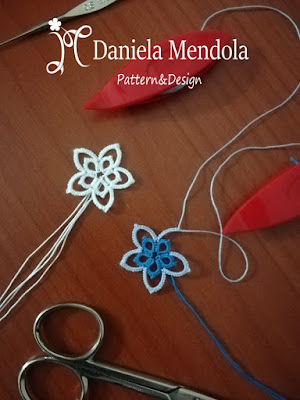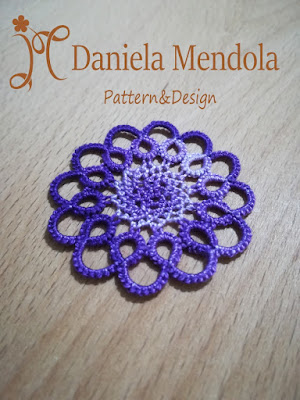domenica 31 marzo 2019
Mimosa Knot - Nodo Mimosa
Many of you asked me how I did the tip to rings and chains of this motif. As I already written in the previous post, it was an experiment and I thank you all for the support and interest that you have shown with your comments.
To work the motif I used thread Babylo size 30 and I inserted the tip instead of a picot both in the rings and in the chains.
To explain the process I used, wanted to write a long post full of photographs and detailed descriptions, but I just couldn't... so I made a video to show how I did the knot that I called Mimosa Knot.
Hope you like it!
To work the motif.
Abbreviations:
Ring = R
Chain = C
double stitch = ds
picot = p
Mimosa Knot = MK
Round 1: a single shuttle is needed.
R of 4ds - 1p - 4ds - 1MK - 4ds - 1p - 4ds. Close.
*R of 4ds - join to the last p of the previous R - 4ds - 1MK - 4ds - 1p - 4ds. Close.*
Repeat from *to* 3 more times, joining the last R to the first one. Cut and tie.
Round 2: two shutlles are needed.
Pass thread of shuttle 2 through a joining p from back to front of the work and wind shuttle 1 with about 15 cm of it.
Work *C of 10ds - 1MK - 10ds - join to the next p.*
Repeat from *to* 4 more times. Cut and tie.
In molti mi avete chiesto come ho fatto a realizzare la punta agli anelli e agli archi di questo motivo. Come già scritto nel post precedente, si è trattato di un esperimento e ringrazio tutti voi per il supporto e l'interesse che mi avete dimostrato con i vostri commenti.
Per lavorare il motivo ho usato il filo Babylo nr. 30 e ho inserito la punta al posto di un picot sia negli anelli che negli archi.
Per spiegare il procedimento che ho usato avrei voluto scrivere un lungo post pieno di fotografie e descrizioni dettagliate, ma non ci sono riuscita... così ho fatto un video per mostrare come ho lavorato il nodo che ho chiamato Nodo Mimosa.
Spero vi piaccia!
Per lavorare il motivo.
Abbreviazioni:
Anello = AN
Arco = AR
nodino doppio = nd
picot = p
Nodo Mimosa = NM
attaccare = att.
Chiudere = Ch.
Giro 1: si lavora con una sola navetta.
AN di 4nd - 1p - 4nd - 1NM - 4nd - 1p - 4nd. Ch.
*AN di 4nd - att. all'ultimo p dell'AN precedente - 4nd - 1NM - 4nd - 1p - 4nd. Ch.*
Ripetere da *a* altre 3 volte, unendo l'ultimo AN al primo. Tagliare e annodare i fili.
Giro 2: si lavora con due navette.
Passare il filo della navetta 2 attraverso uno dei p d'unione dal retro verso il davanti del lavoro e avvolgerlo nella navetta 1 per 15 cm circa.
Lavorare un *AR di 10nd - 1NM - 10nd - att. al p successivo.*
Ripetere da *a* altre 4 volte. Tagliare e annodare i fili.
martedì 26 marzo 2019
It is not a picot! - Non è un picot!
I'm working on a new experiment and am quite satisfied of the result.
It is not a picot that makes pointed the rings and the chains of the motif in this photo, it is a different way to work a double stitch.
Today I done many attemps to get a result that I liked. My idea was to work a flower motif with a different shape of petals, but rings and chains of tatting were always too rounded to resemble my idea of a flower. So I wanted to try something different... and after several attempts, finally, a glimmer of light.
I think I have to do a lot of tests before publishing the working process, but for this evening I've worked hard enough and it's time to take a break, so I hope to come back to this topic soon and I wish you a good night :-)
Sto lavorando a un nuovo esperimento e sono abbastanza soddisfatta del risultato.
Non è un piccolo picot che rende appuntiti gli anelli e gli archi del motivo in questa foto, è un diverso modo di lavorare un nodino doppio.
Oggi ho fatto molti tentativi prima di ottenere un risultato che mi piacesse. La mia idea era quella di lavorare un motivo floreale con una diversa forma dei petali, ma gli anelli e gli archi del chiacchierino erano sempre troppo arrotondati per assomigliare alla mia idea di fiore. Così ho voluto provare qualcosa di diverso... e dopo vari tentativi, finalmente, uno spiraglio di luce.
Penso di dover fare molte prove prima pubblicare il metodo di lavorazione, ma per questa sera ho lavorato abbastanza duramente ed è ora di fare una pausa, perciò spero di tornare presto sull'argomento e vi auguro una buona notte :-)
giovedì 21 marzo 2019
Filigree Stitch - Punto Filigrana
Introduction.
I don't know if this stitch, or something similar, already exists in the shuttle tatting (I will be happy to read your comments on this); the first time I made it was just by chance.
I was working on a pattern and I wanted to fill a large space inside the motif when the shuttle started to work almost autonomously, guiding me in the creation of a delicate weave... delicate like a filigree. Hence the choice of the name.
Premessa.
Non so se questo punto, o qualcosa di simile, esiste già nel chiacchierino a navetta (sarò felice di leggere i vostri commenti al riguardo); la prima volta che l'ho realizzato è stato solo per caso.
Stavo lavorando a un modello e volevo riempire un ampio spazio all'interno del motivo quando la navetta ha iniziato a lavorare quasi autonomamente, guidandomi nella realizzazione di un intreccio delicato... delicato come una filigrana. Da qui la scelta del nome.
***
How I worked.
First of all, I made the motif: R of 4ds - 3p separated by 4ds - 4ds. Close and Reverse Work. C of 12ds. RW.
*R of 4ds - join to the last p of the previous R - 4ds - 2p separated by 4ds - 4ds. Close and RW. C of 12ds. RW.*
Repeat from *to* 10 more times, taking care to join the last ring to the first one.
Cut and tie the threads.
Come ho lavorato.
Per prima cosa ho realizzato il motivo: AN di 4nd - 3p divisi da 4nd - 4nd. Chiudere e voltare. AR di 12nd. Voltare.
*AN di 4nd - attaccarsi all'ultimo p dell'AN precedente - 4nd - 2p divisi da 4nd - 4nd. Chiudere e voltare. AR di 12nd. Voltare.*
Ripetere da *a* altre 10 volte, avendo cura di unire l'ultimo anello al primo.
Tagliare e annodare i fili.
In these photos, I show filigree stitch step by step.
It is worked on the back of the work and is formed by a series of Lock Join for each round of its processing.
The motif has 12 inner picots, so I made 12LJ and, in order to complete the first round, I added the 13th LJ worked into the first picot (13LJ in total - photos from 1 to 6).
In queste foto mostro il punto filigrana passo passo.
Si lavora sul rovescio del lavoro ed è formato da una serie di Lock Join per ciascun giro della sua lavorazione.
Il motivo ha 12 picot interni, così ho eseguito 12LJ e, per completare il primo giro, ho aggiunto la 13ma LJ lavorata sul primo picot (13LJ in totale - foto da 1 a 6).
Then I started the second round, working the next LJ over the bare thread between the LJ of the previous round. This necessary alternation gives a pinwheel effect to the stitch.
Quindi ho iniziato il secondo giro, lavorando le successive LJ sul segmento di filo tra le LJ del giro precedente. Questa necessaria alternanza regala un effetto girandola al punto.
I used a marker to indicate the start of the round and worked 12LJ, then I removed the marker and closed the round working the 13th LJ into that space (photos from 7 to 9). The second round has been made.
3rd round: I repeated another time working 13LJ (photos 10 and 11).
At this point the space within the motif has been reduced, so I started the 4th round skiping the first bare thread to obtain 12LJ in total (photo 12).
5th round: 12LJ.
6th round: 6LJ (I skiped the first bare thread - 1LJ - skiped the next bare thread - 1LJ and continuing in this way up to complete the round).
7th round: 6LJ.
8th round: 3LJ (worked as for the 6th round).
Ho utlizzato un marcatore per segnare l'inizio del giro e ho lavorato 12LJ, poi ho rimosso il marcatore e chiuso il giro lavorando la 13ma LJ in quello spazio (foto da 7 a 9). Il secondo giro è stato completato.
3° giro: ho ripetuto un'altra volta lavorando 13LJ (foto 10 e 11).
A questo punto lo spazio all'interno del motivo si è ridotto, quindi ho iniziato il 4° giro saltando il primo segmento di filo per ottenere 12LJ in totale (foto 12).
5° giro: 12LJ.
6° giro: 6LJ (ho saltato il primo segmento - 1LJ - ho saltato il segmento successivo - 1LJ e continuando in questo modo fino a completare il giro).
7° giro: 6LJ.
8° giro: 3LJ (lavorate con per il 6° giro).
At the end I hidden the ends through some LJ stitches.
Alla fine ho nascosto le estremità attraverso alcuni punti di LJ.
Iscriviti a:
Post (Atom)







